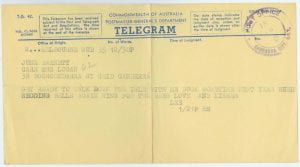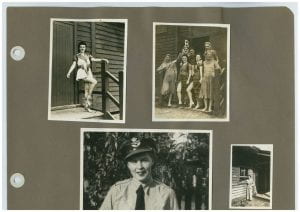A Public and Private Life: June Barnett
June Barnett and Betty Blunden (nee’ Barnett), c1950s. June Barnett collection, 2011.0020
June Barnett was the daughter of a Methodist social reformer who in the 1930s campaigned for improvements to Melbourne’s inner city slums. June joined the Women’s Auxiliary Australian Airforce in the late 1930s. During the war while still in the auxiliary she joined the Communist Party and was active in the Party branch at the University of Melbourne where she studied after the war. She resigned from the Party when she took up a post in the Australian Public Service in Canberra in 1948.
In 1953 she reported to ASIO that a Party functionary had approached her with a request to steal documents for Russia. She was then made a witness at the Petrov Royal Commission into Soviet spying, although she never disclosed the name of the person who approached her.
Reminiscences of travels to Spain, c1980s. June Barnett collection, 2011.0020
She stayed in the public service and became one of the first women to be posted overseas as an official member of the diplomatic corps, when she was appointed to the high commission in New Zealand. She was active in the campaign for equal pay for women public servants.
Her life is documented in a small collection of six boxes predominantly made up of the records of her decades-long relationship with her partner Kay Keightley – including hundreds of photographs, travel documents, correspondence and, finally, the cremation certificate for Kay. Alongside these are correspondence relating to the Royal Commission, documents from her public service career and a few marriage proposals from prospective male suitors.
It is somewhat rare to hold such a complete collection of a long-term lesbian relationship that dated from the period before homosexual sexual relations were even legalised, let alone accepted by broader society. The shape of the collection seems to suggest that even in such a public and eventful life, for June her relationship with Kay was a constant and central focus.
Telegram to June Barnett, c1950s. June Barnett collection, 2011.0020
Finally, back to records that tease the researcher with bygone meaning, is a photo album of June’s time in the WAAAF, that contains a photograph of a naked woman presumably about to go swimming, and what appears to be cross-dressing party costumes. A lot has now been written about queer sexuality and gender identity in the armed forces in World War 2 (see the references below), and much of it speaks to the need to interrogate sources. Evidence of queer sexuality was often suppressed because it was thought to cause embarrassment. What evidence remains tends to focus on male same-sex relations.
WAAAF album, c1940s. June Barnett collection, 2011.0020
WAAAF album, c1940s. June Barnett collection, 2011.0020
The WAAF photo album in June’s collection may be read bearing in mind her later relationship. Also the very act of inserting a photograph of nude women in an otherwise fairly predictable album speaks of an intentionality that should not be ignored. But what more might be said?
So, even a collection in which queer sexuality is quietly but confidently commemorated there are questions that endure, the answers to which might be said to remain private.
References
Graham Willett and Yorick Smaal, ‘‘A homosexual institution’: Same-sex desire in the army during World War II’, Australian Army Journal, vol.10 i.3, 2013
Yorick Smaal, Sex, Soldiers and the South Pacific, 1939–45: Queer Identities in Australia in the Second World War, Palgrave Macmillan, 2015
Andrew Stephens, ‘A secret history of sexuality on the front’ Sydney Morning Herald, 21 DEcember 2012
Frank Bongiorno, The Sex Lives of Australians: A History, Black Ink Books, 2014
Categories





June Barnett was the younger sister of my mother Bett Genevieve Blunden, nee’ Barnett. The first image in this article is described as Being of June and Kaye, when it is actually of June and my mother, Betty (in front of June’s MG). I also knew Kaye very well as I stayed in their apartment in Geneva for over a month when June was representing Australia at the UN’s International Labour Organisation (BET) and the WHO
Thank you Peter. We will update our database with this information.